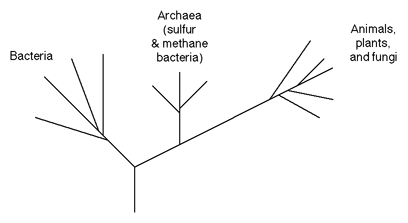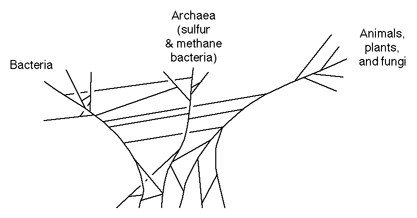|
 |
 |
|
|
Science or Myth?
Why much of what we teach about evolution is wrong
 |
by Jonathan Wells
published by Regnery Publishing, Washington D.C.
248 pages + appendices and notes |
This review (C) January 12, 2002 Darel Rex Finley
Biologist Jonathan Wells shows, item by item, that each major piece of evidence for evolution is ambiguous, seriously distorted, or even downright fraudulent. He then gives examples of how these misleading icons are perpetuated long after their true state has been known, and asks hard questions about textbook authors' claims of ignorance, honest mistake, or justifiable simplification.
I do recommend this book as an excellent supplement to Johnson's Darwin On Trial, but regrettably I must add two caveats:
1. Page 50 features this diagram, representing what was known about the molecular phylogenetic tree of life around 1990:

and page 53 shows this diagram, updated for 2000:

(Diagrams redrawn for this review, with identical content to source material.)
This pair of diagrams is intended to show that the traditional picture of evolutionary, tree-style, branching descent is misleading, and it does show exactly that. But a typical reader might not notice that all multi-celled organisms are contained in the upper-right corner, which does not change from one diagram to the other — it remains a tree-style branching structure. And by Wells's own admission, "bacteria can exchange genes" (p. 53), which could account for the convolutions in the single-celled areas of the new diagram.
Wells is right that the tree of life should no longer be taught as shown in the simpler diagram, but whether this is a problem for evolutionary theory is not clear, and Wells fails to point this out to the reader. I would like to see some examples of tree-violating convolutions in the multi-celled portion of the tree — that would be an important discovery. Could morphological mosaics like the duck-billed platypus offer such molecular evidence?
2. The chapter on horse evolution seems to be going along just fine, but then on page 202 it suddenly changes the subject to directed-vs-undirected evolution, and the severe naturalistic biases of Richard Dawkins. The criticisms of Dawkins are sound, but what happened to horse evolution? Is it valid, or not? Could this chapter have discussed the reduction of the four-toed horse foot to one-toed, in the same light that reduction of four-winged fruit flies to two-winged was discussed on pages 187 and 188 — showing that the change is much more complicated than what could be provided by a few simple mutations?
And even if a horse foot could lose toes to random mutation, it would be nice if the reader had been told that there is a big difference between complexity-reducing/complexity-neutral evolution and complexity-building evolution — specifically, that evidence for the former cannot fill a vacuum of evidence for the latter. With toe reduction being a case of complexity reduction, and overall size increase being complexity-neutral, the horse fossils — at best — are yet another tired example of non-complexity-building evolution, while the bag of complexity-building examples lies strangely empty.
(Readers who want to learn more about the problem of complexity-building in evolution should take a look at William Dembski's just-released No Free Lunch, to be reviewed here in the near future.)
The caveats detailed above do not invalidate the bulk of Wells's fine book, or its important general message that textbooks need to present accurate portrayals of the evidence to students, regardless of the consequences that may have for the continued success of the evolutionary paradigm. But by failing to discuss the above two points, Icons of Evolution veers uncomfortably close to committing the same offense which it condemns: Solidifying one's case through omission and distortive simplification.

This book can be purchased on the Internet from:
Amazon.com
Barnes and Noble
BuyBooks.com
If you know of any other Internet bookstores which stock this book, or if you have any trouble with the stores listed above, please e-mail darel@alienryderflex.com and the list will be updated, as time and circumstances permit. NOTE: The author of this web-page cannot be responsible for the reliability of Internet bookstores.
Web-page content (C) 2002. All company names, products, and product images are copyrighted by their respective copyright holders. This web-page is not affilliated with any persons, companies, or products mentioned herein. Images used for non-commercial, informational purposes only.
|
|
| |